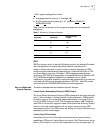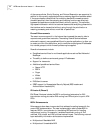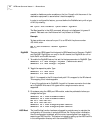
New Features Application Notes 17
■ Improved error handling
■ Help frame resizing now persists across page changes
■ A logout icon for improved security
■ Port list support
■ Support for user-level password changing
Upgrade Management Utilities and NETBuilder Upgrade Link
The remote upgrade process consists of providing customers with a reliable, easy,
and clearly defined way of upgrading their NETBuilder bridge/routers to a newer
version of software and/or firmware. The following changes have been
implemented in this release:
■ Default support for upgrades from 8.x, 9.x, 10.x, or 11.0 to version 11.1
■ Support for FTP file transfers
■ Named backup and restores
■ Improved Upgrade Link user interface with the following:
■ FTP file transfers
■ Stage control
■ Ability to delete old packages
■ Ability to run in client/server mode
See “NETBuilder Upgrade Management Utilities” on page 30 for more
information and Upgrading NETBuilder Family Software for Upgrade Link
operating instructions.
Flash Load
The prior (software versions 11.0 and earlier) flash load process was limited to
formatting the on-board Flash PROM file storage and copying the bundle image to
the firmware and the NETBuilder core boot file onto the file system. With the
introduction of Web, this process needed to be modified to include flash copying
all the appropriate Web Link files as well. This feature allows for multiple file
loading support with the flash load command. This functionality is limited to the
OfficeConnect NETBuilder and SuperStack II SI NETBuilder bridge/router platforms.
New Features
Application Notes
This section provides application notes for the following features:
■ Data over Voice (B-Channel ISDN Specification)
■ Digi64S2
■ ASCII Boot
Placing a Data Over
Voice Call
In many areas, voice calls over ISDN are charged at a lower rate than data calls.
This release of software allows you to specify that calls to a given number be
established as voice calls. This feature is sometimes referred to as a TollSaver
capability. Telephone companies often refer to this type of call as Switched 56
Permissive. The answering device must be capable of generating the 2.1KHz tone


















